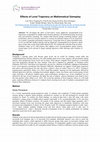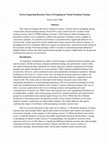Papers by Luke West

Author(s): West, Luke Alexander | Advisor(s): Jun, Sun-Ah | Abstract: The prosodic, and specifica... more Author(s): West, Luke Alexander | Advisor(s): Jun, Sun-Ah | Abstract: The prosodic, and specifically intonation, systems of Tibeto-Burman languages have received less attention in research than those of other families. This study investigates the word prosody and intonation of Sgaw Karen, a tonal Tibeto-Burman language of eastern Burma, and finds similarities to both closely related Tibeto-Burman languages and the more distant Sinitic languages like Mandarin. Sentences of varying lengths with controlled tonal environments were elicited from a total of 12 participants (5 male). In terms of word prosody, Sgaw Karen does not exhibit word stress cues, but does maintain a prosodic distinction between the more prominent major syllable and the phonologically reduced minor syllable. In terms of intonation, Sgaw Karen patterns like related Pwo Karen in its limited use of post-lexical tone, which is only present at Intonation Phrase (IP) boundaries. Unlike the intonation systems of Pwo Karen ...

International Conference of the Learning Sciences Proceedings, 2022
We investigate the effect of free-choice versus adaptively recommended level trajectories on game... more We investigate the effect of free-choice versus adaptively recommended level trajectories on gameplay for middle-school learners playing a 3D architectural game involving ratio and geometric reasoning. We compare data between groups examining students’ game performance and level selection patterns to examine the potential impact of level trajectories on a learner’s gameplay performance and process. Using data from an online-facilitated study (n=23) we find that students playing with an adaptively recommended level trajectory spend more of their time on the target math-related levels. We confirm this with data from an onsite-facilitated study (n=51) and propose that adaptive level recommendation guides learners toward game levels relevant to target learning objectives while allowing some freedom of choice. Authors: Luke West, Fengfeng Ke, Chih-Pu Dai, Byung Joo Kim, Ram Chaulagain, Tusher Chandra Mondol, Jiabei Xu, Renata Kuba, Siho Jung Note: This paper was led by a graduate research assistant on a project funded by the National Science Foundation, grant 1720533. Any opinions, findings, and conclusions or recommendations expressed in these materials are those of the author(s) and do not necessarily reflect the views of the National Science Foundation.

American Educational Research Association Conference Proceedings, 2021
This study investigates the factors related to trainees' reaction time to prompting during virtua... more This study investigates the factors related to trainees' reaction time to prompting during virtual-reality-based teaching training. From 6431 events coded from the recorded virtual training sessions with 33 STEM teaching assistants, 1549 instances where prompting was presented to trainees were examined to address the question of whether session, number of consecutive prompts, or facilitator involvement is associated with a significant difference in reaction time. Linear regression reveals significantly longer reaction time when an instance of prompting involved a facilitator. However, impact on reaction time varied based on the timing of the facilitator prompt. Facilitator prompts within 5 seconds of automated prompts delineated slightly shorter reaction time than non-facilitator prompts in general. Implications for design and facilitation best practice are discussed.
International Conference of the Learning Sciences Proceedings, 2022
High-school-level standardized exams devote 10-15% of their content to grammar and punctuation sk... more High-school-level standardized exams devote 10-15% of their content to grammar and punctuation skills, yet the rules of and best practices for training punctuation are often elusive. We describe an ongoing pilot study where students preparing for the ACT/SAT participate in game-based training sessions for advanced English punctuation. Game levels require active organization of sentences, and students are supported through (1) text from a virtual agent, (2) hints, and (3) a visual cognitive organizer.
University of Toronto Linguistics MA Forum Papers (Unpublished), 2015
In Sgaw Karen, a Tibeto-Burman language with both tone and minor syllables, there exists a class ... more In Sgaw Karen, a Tibeto-Burman language with both tone and minor syllables, there exists a class of similarly prosodically and segmentally reduced morphemes, some lexical and some functional. The presence of functional proclitic morphemes firstly allows for typologically interesting cases, with longer possible minor syllable strings than found in other languages (Butler 2014:18 for Burmese). Secondly, the F0 realization of these minor syllables points to a low pitch target borne by Sgaw’s minor syllable, not
explicable by contextual interpolation. This case study of Sgaw investigates the phonetic status of these reduced syllables in the context of a minor syllable typology, presenting evidence for pitch targets of gradient strengths, all bearing a low phonetic pitch target.
This paper investigates the phenomenon of partial vowel reduplication in Sgaw Karen, a Tibeto-Bur... more This paper investigates the phenomenon of partial vowel reduplication in Sgaw Karen, a Tibeto-Burman language spoken in the Karen state of Burma. While both parallel and serial frameworks are seen to account for most vowel mappings, a few asymmetries lead to pathologies.
An overview is given of Taiwanese revitalization efforts, beginning with the origins of grassroot... more An overview is given of Taiwanese revitalization efforts, beginning with the origins of grassroots movements. The movement is compared to the similar language movements of Quebec and Ireland, noting similarities in socio-political factors. Finally, Taiwanese revitalization is viewed through the lens of the situation of Cantonese, and strategies are proposed for the cultivation of Taiwanese in the next generation.
Prenominal relative clauses are typologically quite rare in languages with VO order. Here a overv... more Prenominal relative clauses are typologically quite rare in languages with VO order. Here a overview is given of prenominal relative clauses in Chinese languages, and contrasting examples are given of pre- and postnominal relative clauses in SVO and SOV languages. Lastly, a proposal is made for why Rel-N VO structure should be such a typological oddity.
This paper was written for a Field Methods course at the University of Toronto, fall 2013. An ove... more This paper was written for a Field Methods course at the University of Toronto, fall 2013. An overview of the phenomenon of velar spirantization in Oromo is given, including sociolinguistic trends proposed by the consultant. Phonetic analysis is made on instances of the voiceless velar stop in carrier phrases. Elicitation of tokens was aimed at uncovering the full spectrum of spirantization from instances of the full velar stop /k/ (though intervocalic), and examples of the allophonic velar fricative [x].
This (undergrad.) paper is a summary of an investigation on topical fronting in Mandarin and Cant... more This (undergrad.) paper is a summary of an investigation on topical fronting in Mandarin and Cantonese. Using the Childes database, two measures were made: the frequency of instances of topical fronting, and the frequency of use of a particle to mark focus. In Cantonese, where a particle most often present to mark the syntactic portion that is moved, children made use of topical fronting more frequently and at an earlier age than Mandarin-speaking children. It is proposed that this difference in acquisition is due to the presence of a vocalized particle in Cantonese, and ultimately a result of the language's productive particle system.
This speech was delivered for the 2013 Annual Chinese Bridge Speech Competition in Toronto, ON. I... more This speech was delivered for the 2013 Annual Chinese Bridge Speech Competition in Toronto, ON. In this short speech, I talk about my personal experience with the many facets of Chinese culture, as well as the attitudes toward Chinese identity that I have noticed over the years. In my understanding, "Chinese culture" as defining one cultural entity is something of a misnomer. I propose that "Chinese" is more of an umbrella term for a number of distinct cultures—each with distinct identities. From my experience I feel cultural identities such as Cantonese, Hakka, and Teochew are distinct but do not detract from people's "Chinese" identity. (对于演讲里的内容,“Chinese"是指属于所谓【中华文化】而不指【属于中国】。)
In this (undergrad.) phonology paper, a preliminary account of Diola-Fogny prefix assimilation is... more In this (undergrad.) phonology paper, a preliminary account of Diola-Fogny prefix assimilation is given in an OT framework.
An brief look at English diminutives is taken with respect to their historical development. Compa... more An brief look at English diminutives is taken with respect to their historical development. Comparisons are drawn between neighbouring Germanic languages.
Conference Presentations by Luke West

171st Meeting of the Acoustical Society of America, 2016
Sgaw Karen is a Tibeto-Burman language with both lexical tone and a major-minor syllable divide. ... more Sgaw Karen is a Tibeto-Burman language with both lexical tone and a major-minor syllable divide. Unlike major syllables, minor syllables are structurally reduced and do not bear overt phonological tone. This acoustic study investigates the fundamental frequency of these minor syllables, summarizing surface pitch patterns and providing evidence for a phonetic target. The first acoustic look at minor syllables in Karenic languages, a phonetically understudied language family, 58 unique minor syllable sequences of each possible length (~500 tokens) are elicited from one native speaker from the Karen State, Myanmar (Burma). Analysis of minor syllable sequences adjacent to lexical tones shows (1) a low pitch target around 185 Hz to which minor syllables asymptotically approximate when given sufficient time, and (2) this target is not explicable by contextual interpolation. Results address the general problem of tonal underspecification and interpret findings in the context of a minor syllable typology. Acoustic surface patterns of the Sgaw Karen minor syllable point to phonetic pitch targets of gradient strengths. Findings provide a foundation for detailed tonal/ intonational analysis of Sgaw Karen, and demonstrates a framework for acoustic documentation of underspecified tonal units in understudied languages of Southeast Asia in general.
Thesis Chapters by Luke West

DISSERTATION: Dynamic visuospatial support (DVS) is an effective tool for helping people learn li... more DISSERTATION: Dynamic visuospatial support (DVS) is an effective tool for helping people learn linguistic tones (Hannah et al., 2017, Morett et al., 2022, Zhen et al., 2019), and learn words with these tonal categories (Baills et al., 2019, Morett et al., 2015). Progress in the field of embodied cognition and learning has led to recent emphasis on the pitch gesture (PG), a hand gesture representing the pitch movement of a tone spatially. However, some non-embodied DVS, like a red dot tracing the same pitch movement, has shown comparable tone learning benefits to PGs (Morett et al., 2022), leaving the role of gesture embodiment unclear. Moreover, how much of a
human agent is visible in DVS varies among recent studies (head+hand, torso+hands, head+torso+hands)—through a learning and media theory lens, this agent embodiment could have a significant learning impact. In this dissertation, I explore the role of embodiment further through a 2x2, pretest-posttest learning intervention study. During 90–120 minutes of typing-based gameplay, 68 adult naive learners of Mandarin Chinese viewed a total of 60 DVS videos, which conveyed the pronunciation of 15 2-syllable vocabulary items, and represented linguistic tone in 1 of 4 ways: (1) a human agent with a hand gesturing, (2) invisible agent with a visible
hand gesturing, (3) a still human agent with a red dot gesturing, and (4) no agent with a red dot gesturing. Assessments measured pre- and posttest tone recognition for 1- and 2-syllable nonce words, and posttest word recall of the vocabulary items.
First, an interaction effect of gesture embodiment and agent embodiment for word recall revealed that learners benefited significantly more when DVS was either fully embodied or fully non-embodied, than when partially embodied. Findings suggest that the word learning benefit of high embodiment in a DVS agent outweighs other cognitive hindrance introduced by the agent, in line with principles for pedagogical agents from media theory (Mayer, 2017). Conversely, findings reinforce the notion that the visuospatial metaphor is a powerful word learning scaffold,
comparably effective to embodied DVS, and more effective than DVS with compromised embodiment. Second, non-significant differences in tone recognition learning gains between conditions suggest that the scaffolding of tone category learning is not sensitive to embodiment
effects in the same way as word learning. Post-hoc tests showed significant positive correlation between gameplay progress and word recall, suggesting that using the vocabulary items for problem solving means was particularly helpful for participants. In light of the findings, I suggest educators and designers use highly embodied or fully non-embodied DVS when supporting tonal word learning, especially in hands-on L2 problem solving activities, like digital games.










Uploads
Papers by Luke West
explicable by contextual interpolation. This case study of Sgaw investigates the phonetic status of these reduced syllables in the context of a minor syllable typology, presenting evidence for pitch targets of gradient strengths, all bearing a low phonetic pitch target.
Conference Presentations by Luke West
Thesis Chapters by Luke West
human agent is visible in DVS varies among recent studies (head+hand, torso+hands, head+torso+hands)—through a learning and media theory lens, this agent embodiment could have a significant learning impact. In this dissertation, I explore the role of embodiment further through a 2x2, pretest-posttest learning intervention study. During 90–120 minutes of typing-based gameplay, 68 adult naive learners of Mandarin Chinese viewed a total of 60 DVS videos, which conveyed the pronunciation of 15 2-syllable vocabulary items, and represented linguistic tone in 1 of 4 ways: (1) a human agent with a hand gesturing, (2) invisible agent with a visible
hand gesturing, (3) a still human agent with a red dot gesturing, and (4) no agent with a red dot gesturing. Assessments measured pre- and posttest tone recognition for 1- and 2-syllable nonce words, and posttest word recall of the vocabulary items.
First, an interaction effect of gesture embodiment and agent embodiment for word recall revealed that learners benefited significantly more when DVS was either fully embodied or fully non-embodied, than when partially embodied. Findings suggest that the word learning benefit of high embodiment in a DVS agent outweighs other cognitive hindrance introduced by the agent, in line with principles for pedagogical agents from media theory (Mayer, 2017). Conversely, findings reinforce the notion that the visuospatial metaphor is a powerful word learning scaffold,
comparably effective to embodied DVS, and more effective than DVS with compromised embodiment. Second, non-significant differences in tone recognition learning gains between conditions suggest that the scaffolding of tone category learning is not sensitive to embodiment
effects in the same way as word learning. Post-hoc tests showed significant positive correlation between gameplay progress and word recall, suggesting that using the vocabulary items for problem solving means was particularly helpful for participants. In light of the findings, I suggest educators and designers use highly embodied or fully non-embodied DVS when supporting tonal word learning, especially in hands-on L2 problem solving activities, like digital games.
explicable by contextual interpolation. This case study of Sgaw investigates the phonetic status of these reduced syllables in the context of a minor syllable typology, presenting evidence for pitch targets of gradient strengths, all bearing a low phonetic pitch target.
human agent is visible in DVS varies among recent studies (head+hand, torso+hands, head+torso+hands)—through a learning and media theory lens, this agent embodiment could have a significant learning impact. In this dissertation, I explore the role of embodiment further through a 2x2, pretest-posttest learning intervention study. During 90–120 minutes of typing-based gameplay, 68 adult naive learners of Mandarin Chinese viewed a total of 60 DVS videos, which conveyed the pronunciation of 15 2-syllable vocabulary items, and represented linguistic tone in 1 of 4 ways: (1) a human agent with a hand gesturing, (2) invisible agent with a visible
hand gesturing, (3) a still human agent with a red dot gesturing, and (4) no agent with a red dot gesturing. Assessments measured pre- and posttest tone recognition for 1- and 2-syllable nonce words, and posttest word recall of the vocabulary items.
First, an interaction effect of gesture embodiment and agent embodiment for word recall revealed that learners benefited significantly more when DVS was either fully embodied or fully non-embodied, than when partially embodied. Findings suggest that the word learning benefit of high embodiment in a DVS agent outweighs other cognitive hindrance introduced by the agent, in line with principles for pedagogical agents from media theory (Mayer, 2017). Conversely, findings reinforce the notion that the visuospatial metaphor is a powerful word learning scaffold,
comparably effective to embodied DVS, and more effective than DVS with compromised embodiment. Second, non-significant differences in tone recognition learning gains between conditions suggest that the scaffolding of tone category learning is not sensitive to embodiment
effects in the same way as word learning. Post-hoc tests showed significant positive correlation between gameplay progress and word recall, suggesting that using the vocabulary items for problem solving means was particularly helpful for participants. In light of the findings, I suggest educators and designers use highly embodied or fully non-embodied DVS when supporting tonal word learning, especially in hands-on L2 problem solving activities, like digital games.